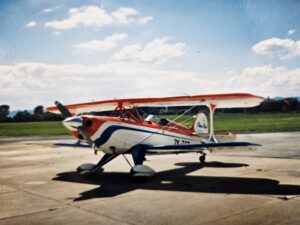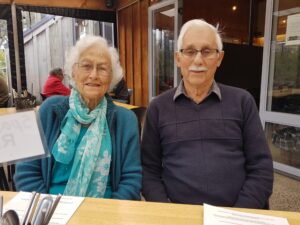Born in Gisborne 1931, the day before the infamous Napier earthquake, Bruce Thompson, has spent more than half his life in the air. However, at ground level, he still lives half a mile from the school he went to as a young lad.

His passion for flying came from an early age, and at seventeen, while completing a motor mechanic apprenticeship, he started his training to fly. Shortly after this, aged twenty-two, the Korean War was heating up, he completed three months of compulsory military training at RNZAF Taeri, Dunedin. Upon his return to Gisborne, he joined the Field Air Limited. He spent eight to ten months working in the hangar, occasionally ferrying aeroplanes between New Zealand airports before getting his commercial license.
“In those days,” Bruce tells me, “There was no training programme for top dressing” and upon receiving his commercial license he practiced with a quarter ton of sand to get the feel of overload. The following day he was out to work with the senior pilot on the job. “It was 1954 when I started topdressing and 1955 when I married my wife, Margaret.
During his days topdressing, Bruce flew many types of aircraft including a Tiger Moth, D.H. Beaver, Lodestar, and Douglas DC3. As fuel prices from the early 80’s continued to rise, Bruce flew his last DC3 in 1987 after flying over 23,000 hours and continued to work on the planes in the hangar.
In 1975 , Bruce started to build a fully aerobatic Skybolt, a two-seater biplane. He first flew it in 1982 until 2001 he was 70 years old. It still lives in a hangar, and his son, Glen, an aircraft engineer, still flies it occasionally. Bruce said, “It became too complicated to maintain a pilot license with expensive medical tests introduced and I think I’d had enough of flying by then.”
Bruce was about 50 when he started to see a change in his eyesight. “When I was flying, I had to have an eye check every few years. My optometrist told me I had a bit of pressure in my eyes and referred me to a specialist. I popped the letter on the mantelpiece for a year or two, and unfortunately, Mr Robinson died and I didn’t want to go to the appointment with a referral letter from a deceased person, so when I finally did have an appointment, it was confirmed I had glaucoma. That was about 42 years ago, and since then, I have attended Gisborne Hospital every six months or so, seeing a different specialist each time as we don’t have a permanent eye specialist at the hospital”.
At about the age of 70, Bruce experienced double vision. Following a couple of scans and in consultation with the eye specialist, he was given corrective lenses that allow him to complete most activities, except driving, which he stopped at age 91 when he momentarily saw ‘ ghost cars’ coming toward him.
Bruce’s glaucoma has been managed with daily eye drops, and other than the double vision, he still enjoys a full life with his wife of sixty-eight years in the same house he built with this father.